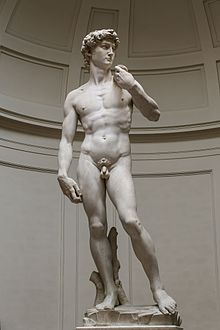
The historical evolution of the nude in art runs parallel to the history of art in general, except for small particularities derived from the different acceptance of nudity by the various societies and cultures that have succeeded each other in the world over time. The nude is an artistic genre that consists of the representation in various artistic media (painting, sculpture or, more recently, film and photography) of the naked human body. It is considered one of the academic classifications of works of art. Nudity in art has generally reflected the social standards for aesthetics and morality of the era in which the work was made. Many cultures tolerate nudity in art to a greater extent than nudity in real life, with different parameters for what is acceptable: for example, even in a museum where nude works are displayed, nudity of the visitor is generally not acceptable. As a genre, the nude is a complex subject to approach because of its many variants, both formal, aesthetic and iconographic, and some art historians consider it the most important subject in the history of Western art.[Note 1]
Although it is usually associated with eroticism, the nude can have various interpretations and meanings, from mythology to religion, including anatomical study, or as a representation of beauty and aesthetic ideal of perfection, as in Ancient Greece. Its representation has varied according to the social and cultural values of each era and each people, and just as for the Greeks the body was a source of pride, for the Jews—and therefore for Christianity—it was a source of shame, it was the condition of slaves and the miserable.[1]
The study and artistic representation of the human body has been a constant throughout the history of art, from prehistoric times (Venus of Willendorf) to the present day. One of the cultures where the artistic representation of the nude proliferated the most was Ancient Greece, where it was conceived as an ideal of perfection and absolute beauty, a concept that has endured in classical art until today, and largely conditioning the perception of Western society towards the nude and art in general. In the Middle Ages its representation was limited to religious themes, always based on biblical passages that justified it. In the Renaissance, the new humanist culture, of a more anthropocentric sign, propitiated the return of the nude to art, generally based on mythological or historical themes, while the religious ones remained. It was in the 19th century, especially with Impressionism, when the nude began to lose its iconographic character and to be represented simply for its aesthetic qualities, the nude as a sensual and fully self-referential image. In more recent times, studies on the nude as an artistic genre have focused on semiotic analyses, especially on the relationship between the work and the viewer, as well as on the study of gender relations. Feminism has criticized the nude as an objectual use of the female body and a sign of the patriarchal dominance of Western society. Artists such as Lucian Freud and Jenny Saville have elaborated a non-idealized type of nude to eliminate the traditional concept of nudity and seek its essence beyond the concepts of beauty and gender.[2]
Cite error: There are <ref group=Note> tags on this page, but the references will not show without a {{reflist|group=Note}} template (see the help page).
- ^ Calvo Serraller (2005, p. 62)
- ^ Newall (2009, p. 21)